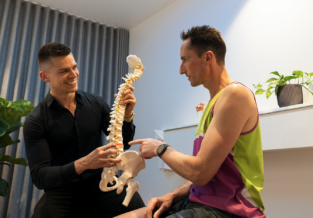Overuse/Repetitive Strain Injuries (RSI)
Published on
17 May 2017

Call us on: (03) 9975 4133
Overuse injuries, also known as repetitive strain injuries (RSI) are caused by repeated stress on your body without sufficient time to recover, repair and adapt. In athletes, overuse injuries are typically caused by training errors. That means the athlete has increased the amount, intensity or type of training too quickly.
Common Overuse Injuries
- Plantar facsciitis, due to a significant increase in walking or running or a sudden change in footwear
- Achilles tendinopathy in January when everyone is back in the gym doing box jumps, high intensity interval training classes and sprint training after having six weeks off over the festive season
- Tennis and Golfers Elbow in spring, when everyone is back out enjoying the sun and fitting in 2 rounds of golf and 4 hours of tennis at the weekend.
Adapting To Load And Demand
Our bodies are incredible at adapting to load and can tolerate the normal daily life that we put it through. When you introduce a new activity or exercise, your body needs time to adapt to the increase in demand. If you follow a weight training programme at the gym, you will notice an increase in the weight that you can lift after six weeks as your muscles and tendons have adapted and are stronger. However, if you do too much, too soon, your body does not have time to adapt and the result is an injury.
When you perform a new exercise or activity that your body is not used to, it places increased demand on your muscles, tendons and bones. This is the stiffness and sore muscle feeling, the morning after your first gym session, run or walking the 1000 steps. The new load has caused microtrauma in your muscles, tendons and bones that will repair over the next few days and allow your body to adapt to the new demands. If you continue to load your body, without the appropriate rest, you will experience further microtrauma, before your body has time to repair the initial microtrauma. Repeated loading will then result in an injury.
How To Avoid Overuse Injuries
The best way to avoid an overuse injury is to gradually increase your loading over a period of time. So what does this actually mean? How much is too much.
The 10% Rule
If you are following a training plan for a running event or triathlon, most plans will increase training volume by 10% each week for 3-4 weeks and then have a lighter week with less volume known as a recovery week. This is the time for your body to recover and adapt to the training and enable you to push harder in the next training block.
This 10% guideline can be applied to any sort of activity or exercise. If your smart watch reads 10,000 steps on average a day, look at adding an extra 100 steps per day in the first week, 200 in the 2nd week, 300 in the 3rd week and then have a slightly lighter week, before increasing to 10,400per day by week 5.
Listen To Your Body
If it feels tired and sore, give it a few days rest. This will allow you to increase your exercise and training and reduce your injury risk.
Want To Hear More On Overuse Injuries From Liz?
Check out Liz’ interview with Ed Philips on the Health & Wellbeing show for Talking Lifestyle HERE ! Follow our Facebook for updates on when Liz will make her next appearance on the Health & Wellbeing show between 1pm-2pm on 1278AM weekdays!



